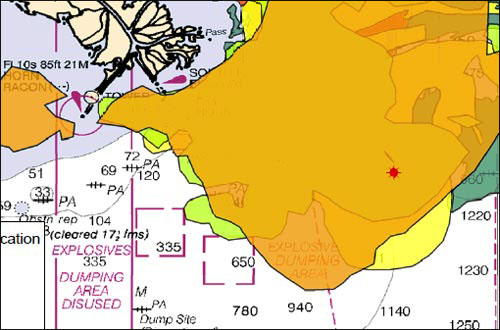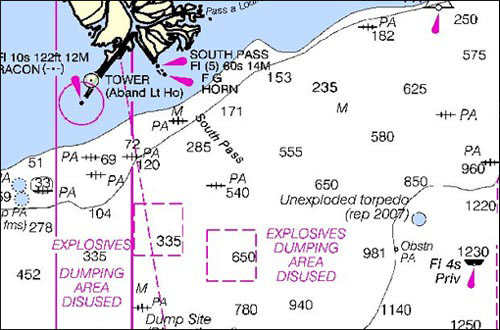may  2010
2010
 While it is abundantly clear that we're living in the future — after all, we have a black President (and by we, of course I mean the US), which I've long maintained is one of the most reliable signs that you are living in the future. Other signs include AI, flying cars, contact with aliens and, of course, global nuclear or nanotechnological apocalypse. What is equally clear is that it's still up for grabs which future we've actually wrought.
While it is abundantly clear that we're living in the future — after all, we have a black President (and by we, of course I mean the US), which I've long maintained is one of the most reliable signs that you are living in the future. Other signs include AI, flying cars, contact with aliens and, of course, global nuclear or nanotechnological apocalypse. What is equally clear is that it's still up for grabs which future we've actually wrought.
Is it the transhumanist technological wonderland, where a dizzying acceleration of paradigm-shattering breakthroughs across the sciences rapidly and collectively expands our minds past the conceptual horizon of any human limitation? Or is it the tragic Dystopian tale, a warning beacon for some far-future consciousness, of the little blue planet that almost made it; in which our ingenious, intemperate, insatiable species sows the seeds of self-destruction in a final act made inevitable by its own omnivoracious hubris?
Here's why I ask. Today the BBC reported about a British scientist who says he is the first man in the world to become infected with a computer virus. Just in case anyone was waiting for the other shoe to drop after last week's announcement by Craig Venter and co. that they've synthesized the world's first artificial living organism. Or as one cute chick at The Guardian cleverly summed it up:
"Anyway, that's what he's done. Created life in a lab. Opened up a gargantuan raft of possibilities hitherto only seen in sci-fi films. Via synthetic bacteria created to mop up carbon or excrete biofuels, his work could save humanity, or destroy it via new bioweaponry of apocalyptic proportions. And ISN'T it going to be fun finding out!?" — Lucy Mangan
See what I mean? Our brains may be capable of many things but assimilating this kind of point-counterpoint at such a rapid pace just isn't one of them. That's the kind of thing that gets us all discombobulated and makes even the best among us start spewing quotes from Yeats and Huxley.
 On the one hand, we're a decade into the 21st century and we still don't have flying cars, and at this rate it doesn't look like we'll get them any time soon. On the other hand — and this is no small consolation, as anyone from my mother's generation or mine will agree — we are not living in a post-nuclear wasteland, holed up with an arsenal of looted machine guns in some godforsaken mountain shack miles from the nearest fallout zone, subsisting on canned goods and rainwater while we fend off roving bands of mutants — unfortunate souls who lived too far from the nearest city to be vaporized instantly but too close for their DNA not to be frappéd by radiation.
On the one hand, we're a decade into the 21st century and we still don't have flying cars, and at this rate it doesn't look like we'll get them any time soon. On the other hand — and this is no small consolation, as anyone from my mother's generation or mine will agree — we are not living in a post-nuclear wasteland, holed up with an arsenal of looted machine guns in some godforsaken mountain shack miles from the nearest fallout zone, subsisting on canned goods and rainwater while we fend off roving bands of mutants — unfortunate souls who lived too far from the nearest city to be vaporized instantly but too close for their DNA not to be frappéd by radiation.
Here's another example. This past week BP produced for their rapt and captive audience a live video feed of their oil spill — streaming as it were — in real time from the very depths of its unstoppable source 5,000 feet beneath the surface.
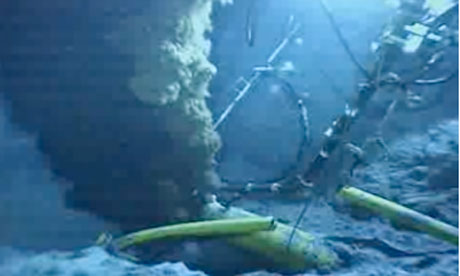
[Live video of BP oil spill.]
And yet — and yet — the very same week in human history that this stomach-churningly vile catastrophe is being broadcast to the whole wide web, we are beamed another video feed. This one comes to us, as if by miraculous transmission from a higher being — which is none other than us, or the scientists at NASA among us — whose busy, brilliant little minds programmed the Cassini spacecraft (charmingly described by the Boston Globe as "school bus-sized") to fly 870 million miles from the Earth and send us back close-ups of Saturn and its moons. Did you know that Saturn produces its own aurora, just like our Northern Lights but 746 miles high? Of course you didn't — nobody knew until this very week! Now we have a little animated gif of them and we can copy and paste it for free onto our web log, just like we invented it.

[Saturn's Northern Lights — captured by NASA's Cassini spacecraft.]
Enough about the future — I'm still on this kick from the weekend, so here are a few more pairs of images.
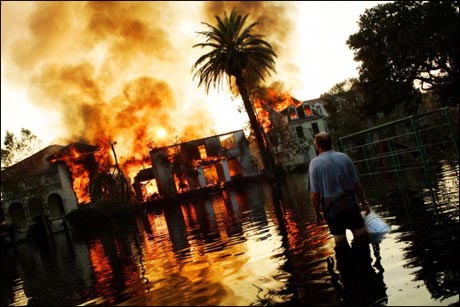
[Hurricane Katrina Aftermath, New Orleans]

[The Course of Empire: Destruction by Thomas Cole]
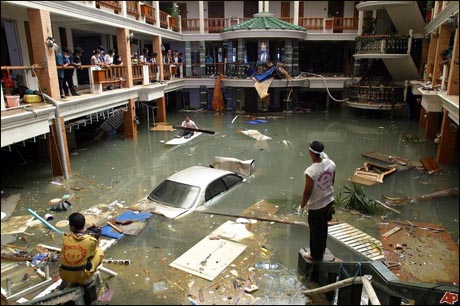
[Asia Tsunami, 2004 — AP photo]

[Atlantis, artist to be named when I find it again.]
![]() This is the intellectual level to which I've recently been reduced. I hate to pass the buck (oh, hell, not really) but I'd like to say right off the bat that this wasn't my idea. A friend forwarded me this link and I take full responsibility for the hijinks that ensued after that. I am such a geek...
This is the intellectual level to which I've recently been reduced. I hate to pass the buck (oh, hell, not really) but I'd like to say right off the bat that this wasn't my idea. A friend forwarded me this link and I take full responsibility for the hijinks that ensued after that. I am such a geek...
I never noticed it before but, boy, when you take Obama out of this picture, it really does have a certain Bolshevik Revolution/collectivist workers' paradise feel to it, doesn't it? Which is what got me started on the first of my many downwardly-spiraling tangents over the weekend...
Political propaganda art has got to be one of the most fascinating sub-categories of commercial illustration, like the rock concert poster art of the 1960s and (dare I draw this comparison) the rave flyer art of the early 90s. World War II, without a doubt, represented a pinnacle in the art of persuasion. Funny how the geopolitical machinations of one failed artist ended up being the catalyst for a global renaissance, ushering in an unprecedented explosion of simultaneous inspiration in the genre.
 The National Archives gallery has a great collection called Powers of Persuasion, which I've known about for a long time. A year ago, I sent my friend at work a link to the classic "When you ride alone, you ride with Hitler" poster — famously parodied by Bill Maher a few years back — apparently she's not a Bill Maher fan though, because she had never seen or heard of this little historical gem. In fact, she found it amusing beyond all reasonable expectation, especially in light of the contrast to how our present political leaders approach the intersection of our two most taboo topics, foreign oil and war. They encouraged consumers — er, citizens — to conserve fuel — how quaint! Maybe one day I'll tell her about the aluminum collection drives that took place in Britain during the blitz.
The National Archives gallery has a great collection called Powers of Persuasion, which I've known about for a long time. A year ago, I sent my friend at work a link to the classic "When you ride alone, you ride with Hitler" poster — famously parodied by Bill Maher a few years back — apparently she's not a Bill Maher fan though, because she had never seen or heard of this little historical gem. In fact, she found it amusing beyond all reasonable expectation, especially in light of the contrast to how our present political leaders approach the intersection of our two most taboo topics, foreign oil and war. They encouraged consumers — er, citizens — to conserve fuel — how quaint! Maybe one day I'll tell her about the aluminum collection drives that took place in Britain during the blitz.
 The recruitment posters were the best, though — and they've aged so well, too! I mean, what self-respecting young man of any era could resist the call to "man the guns" and join the Navy? A straight man, you say? Psha!
The recruitment posters were the best, though — and they've aged so well, too! I mean, what self-respecting young man of any era could resist the call to "man the guns" and join the Navy? A straight man, you say? Psha!
If you think that's simmering with none-too-subtle homoerotic subtext, check out this one from Italy... I can't begin to imagine what's going on here but... um, mrreow.
Well, you know what they say...
 So, back to the subject of that communist revolutionary look I'm sporting above. It reminds me of this incident back in high school, which I attended in the ever so politically diverse cultural mecca of Charlottesville, Virginia — and yes, I know The Dave Matthews Band is from there — I went to school with the bass player, for god's sake. One band does not a cultural mecca make. Anyway, over the summer when my boyfriend and I first started seeing each other, he had this cool-slash-dorky green army hat with a Red Army star on it and I, being a girl and prone to doing such things as girls are, wore it as much as possible. I looked adorable in it and he liked the way it smelled like Stiff Stuff hairspray when he took it back at the end of the day. Win-win all around.
So, back to the subject of that communist revolutionary look I'm sporting above. It reminds me of this incident back in high school, which I attended in the ever so politically diverse cultural mecca of Charlottesville, Virginia — and yes, I know The Dave Matthews Band is from there — I went to school with the bass player, for god's sake. One band does not a cultural mecca make. Anyway, over the summer when my boyfriend and I first started seeing each other, he had this cool-slash-dorky green army hat with a Red Army star on it and I, being a girl and prone to doing such things as girls are, wore it as much as possible. I looked adorable in it and he liked the way it smelled like Stiff Stuff hairspray when he took it back at the end of the day. Win-win all around.
 Except for this one time when we went to, of all places, the newly-opened marble slab ice cream shop — which are apparently everywhere now (and rightfully so, don't get me wrong) — but that's not the point of the story. So, there we are, a slightly cuter-than-average pair of 16-year olds, going out for ice cream in the middle of summer in Virginia. It's 90 degrees out with 90 percent humidity and the air conditioning in this ice cream place is enough to make your teeth chatter by the time you've finished ordering. So we've got our arms all wrapped around each other like teenagers often do, and the guy behind the counter is nice enough not to shout at us to get a room. In fact, he's chatting away at us as he's making our order, friendly as anything you'd hope to find at an ice cream shop on a cobblestone street in Jefferson's Virginia. Then, as he's handing us our change, he suddenly gets this look on his face and says (to me) all serious-like, "I have to ask... why are you wearing a communist hat?"
Except for this one time when we went to, of all places, the newly-opened marble slab ice cream shop — which are apparently everywhere now (and rightfully so, don't get me wrong) — but that's not the point of the story. So, there we are, a slightly cuter-than-average pair of 16-year olds, going out for ice cream in the middle of summer in Virginia. It's 90 degrees out with 90 percent humidity and the air conditioning in this ice cream place is enough to make your teeth chatter by the time you've finished ordering. So we've got our arms all wrapped around each other like teenagers often do, and the guy behind the counter is nice enough not to shout at us to get a room. In fact, he's chatting away at us as he's making our order, friendly as anything you'd hope to find at an ice cream shop on a cobblestone street in Jefferson's Virginia. Then, as he's handing us our change, he suddenly gets this look on his face and says (to me) all serious-like, "I have to ask... why are you wearing a communist hat?"
I don't remember my exact words but they were definitely not serious; I said something flippant like, because it keeps the hair out of my eyes, or because I look super cute in it. He was not impressed and proceeded to give us this weird, rambling lecture about how it was inappropriate and people could be offended and — well, just a long, awkward mess of an uninvited monologue on my choice of fashion accessory — from what appeared to be one of the world's least qualified critics. We extracted ourselves as politely as possible — which, after all that, wasn't very politely at all — and eventually we were able to redeem the experience through frequent retellings in the days and weeks ahead, to anyone who would listen, or who overheard us making fun of him by calling each other "Comrade" and "Stolichnaya."
 What's amazing in hindsight is that Charlottesville in the early 90s was still such a throwback of a Reaganite suburban backwater that this guy had apparently never encountered a teenage "revolutionary" sporting a Che Guevara t-shirt. Ether that or we weren't the only kids in town getting lectured about our lack of respect for the great capitalist utopia we were living in... Ah yes, just like old Jefferson intended, but without the slaves and with all the farmland bulldozed for Wall-Marts and the plantations industrialized into factory feedlots run by illegal immigrants from Mexico.
What's amazing in hindsight is that Charlottesville in the early 90s was still such a throwback of a Reaganite suburban backwater that this guy had apparently never encountered a teenage "revolutionary" sporting a Che Guevara t-shirt. Ether that or we weren't the only kids in town getting lectured about our lack of respect for the great capitalist utopia we were living in... Ah yes, just like old Jefferson intended, but without the slaves and with all the farmland bulldozed for Wall-Marts and the plantations industrialized into factory feedlots run by illegal immigrants from Mexico.
This is more like it... in the Facebook-era, revolutionaries don't wear dead communists on their t-shirts. All one needs is Photoshop and a printer with a half-full black ink cartridge and voila, you are your very own iron-on cult of personality icon.
So then I started freeform pattern-associating and found all this cool stuff... I often notice these unexpected echoes of familiar imagery in the news — not because they're staged, although of course, some are — but just because if you take enough pictures of events that deservedly capture the public's attention, you're bound to find repetitions of the same patterns that are already a part of the human historical and artistic record.


Once you start noticing them, you see these parallels everywhere...
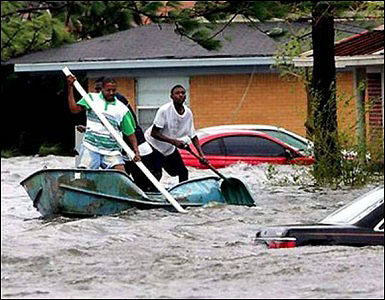
The Mississippi — New Orleans (2005)

The Styx, Dante's Inferno — Gustav Dore (1861)
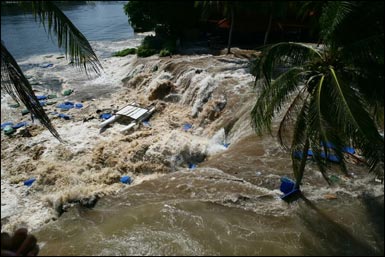
Tsunami — Phuket, Thailand (2004)

The Deluge — Francis Danby (1840)
 I was surfing aimlessly today, as one tends to do on a Sunday, when I found this GOOD magazine article entitled Are You an Asker or a Guesser? If you're thinking hmm, that sounds intriguing, that was my first thought exactly (immediately followed by "where do I take the quiz to find out?"). The article is brief, for the most part paraphrasing the original MetaFilter post that started the meme which, just last week, The Guardian sent snowballing towards cultural ubiquity.
I was surfing aimlessly today, as one tends to do on a Sunday, when I found this GOOD magazine article entitled Are You an Asker or a Guesser? If you're thinking hmm, that sounds intriguing, that was my first thought exactly (immediately followed by "where do I take the quiz to find out?"). The article is brief, for the most part paraphrasing the original MetaFilter post that started the meme which, just last week, The Guardian sent snowballing towards cultural ubiquity.
Quoting from the original post, Ask Culture meets Guess Culture:
"In some families, you grow up with the expectation that it's OK to ask for anything at all, but you gotta realize you might get no for an answer. This is Ask Culture. In Guess Culture, you avoid putting a request into words unless you're pretty sure the answer will be yes. A key skill is putting out delicate feelers. If you do this with enough subtlety, you won't even have to make the request directly; you'll get an offer. Even then, the offer may be genuine or pro forma; it takes yet more skill and delicacy to discern whether you should accept.
If you're a Guess Culture person... then unwelcome requests from Ask Culture people seem presumptuous and out of line, and you're likely to feel angry, uncomfortable, and manipulated. If you're an Ask Culture person, Guess Culture behavior can seem incomprehensible, inconsistent, and rife with passive aggression." — by tangerine
Indeed, I thought, I need to know more... After failing in my quest for the aforementioned quiz (though I'm sure as we speak someone is on the job...), I searched "Ask vs. Guess Culture" and found a follow-up thread on MetaFilter. Despite having every intention of stopping after a few comments, I found myself not just scanning but actually absorbed for over an hour reading almost every single one of the 276 responses to date. Not in the way you read YouTube comments, either — you know, when you've watched something and you're trying to figure out how to email it to a particular friend — not, say, posting it on Facebook and alerting all your friends, relatives, coworkers and all their friends — when your eyes accidentally stray to the comments and you find yourself reading the first one, then the next one, then another and another, fully loathing yourself and cursing your weakness all the while. As I was saying, it wasn't like that at all.
 Reading those 276 comments, I found them — I hesitate to say all, but I honestly can't think of one exception — well articulated, carefully considered and immensely enlightening. Early on, someone commented that "tangerine" should write a book about Ask Culture vs. Guess Culture, expanding the descriptions quoted above and giving illustrative examples, maybe dividing it into chapters like "Ask vs. Guess culture at work," "...in love," etc., and maybe bringing in the cultural/regional influences that were brought up by other commenters, broadening the scope and adding global relevance to the original hypothesis.
Reading those 276 comments, I found them — I hesitate to say all, but I honestly can't think of one exception — well articulated, carefully considered and immensely enlightening. Early on, someone commented that "tangerine" should write a book about Ask Culture vs. Guess Culture, expanding the descriptions quoted above and giving illustrative examples, maybe dividing it into chapters like "Ask vs. Guess culture at work," "...in love," etc., and maybe bringing in the cultural/regional influences that were brought up by other commenters, broadening the scope and adding global relevance to the original hypothesis.
Many commenters talked about family traditions and how the two "cultures" also have roots in our national and regional identities. Minnesota Nice, New England Chill, Southern politeness and Iranian hospitality were all cited as classic examples of "Guess cultures," whereas commenters from Australia, Hungary and Russia readily labeled themselves and their nations of origin as "Ask cultures," as did several engineers, partners of engineers and other self-identifying "nerds." I would strongly recommend this thread to anyone who can spare an hour or so, if for no other reason than the pure enjoyment of having so many "holy shit, it's not just me" moments in one sitting.
Just for fun, here are a few of the comments that did that for me:
- "Part of the reason why I'm a guesser is that I have a hard time coping with people telling me no, because I have a bad habit of assuming they've told me no because they hate me a little bit." — by infini
- "I have such immense difficulty asking for things it is ludicrous. I couch requests with so many apologetic sub-clauses for daring to disturb someone's peace that it's amazing anyone understands that I am asking for something at all." — by winna
Reading that last one, my instinctive reaction was such a perfect split between the two extremes of laughing hysterically and cringing in pained denial that I was afraid I might rupture something. Then there was the P.S.:
- "It always amused me when I took people from other regions home to meet my mother. They would enthuse about how charming and warm she was! what a lovely woman! meanwhile, I knew perfectly well what it meant that my mom didn't press second and third helpings of food on them and grill them nicely about who their people were for an hour. They never did understand why I could never invite them back home — my mother was screaming OH LORD I HATE YOU in her own deeply passive way." — by winna
Oh my god. Even though the closest I ever came to living in the South was the college town of Charlottesville, Virginia, and my personal claim to Southern heritage is three generations removed, I felt what can only be described as an ancestral pang of recognition at that one. Then there was this:
- "Here's a rubric for knowing if you've got at Asker or a Guesser on your hands: ask them if they are hungry. A Guesser will describe their state as being both content to wait for food and amenable to eating something anyway." — by xo
 Oh my fucking god, did I laugh at that. Because just last night I was having this conversation with Mr. Pink after a friend had called to invite us out and I was ambivalent because I hadn't been given a week to prepare myself mentally (to say nothing of follicly). She had already called three times at this point and I still hadn't managed to give her a definite answer (twice I had tried to hand the phone to my designated extravert Mr. Pink, only to be met with scornful head shaking). After hanging up the third time and promising to call back with a yes or no within the hour, we had this exchange:
Oh my fucking god, did I laugh at that. Because just last night I was having this conversation with Mr. Pink after a friend had called to invite us out and I was ambivalent because I hadn't been given a week to prepare myself mentally (to say nothing of follicly). She had already called three times at this point and I still hadn't managed to give her a definite answer (twice I had tried to hand the phone to my designated extravert Mr. Pink, only to be met with scornful head shaking). After hanging up the third time and promising to call back with a yes or no within the hour, we had this exchange:
Mr. Pink: What's so complicated? Do you want to go out?
Me: I don't know... I could go out.
Mr. Pink: I know you could, but do you want to? It's a simple question.
Me: Well, no, it's not that simple. I don't really feel like it right now but if I make myself go, I'd probably end up having a good time — or, you know, not — but that would be okay too...
Mr. Pink: If you don't want to go, just say you don't want to go.
Me: But I feel bad...
Mr. Pink: Why?
Me: Because she won't go out if we don't go.
Mr. Pink: She said that?
Which sort of let me off the hook a little... but I only recount this story in order to illustrate how completely involuntary and indelibly ingrained these patterns of behavior can be, in my experience anyway. I should also add that I am all too dreadfully aware of how insufferable all that sounded, even as I was saying it, and how unfair it must seem to the person on the other end. Here's another comment that set off alarm bells of recognition:
- "I wonder if there is a correlation between askers/guessers and those who like/dislike the phone. I am a hardcore guesser and I despise the phone. Thankfully, most of the time, you can just wait... and ponder before replying — which you can't do in person. The opposite is true in that I hate having to call someone. It feels like such an interruption and that I will be putting someone on the spot... The phone rang about 3 min ago. My adrenaline rush and shuddering just wore off enough for me to post this." — by mephisjo
I honestly thought it was just me. But no... As it turns out, we are legion.
- "YES! The idea of even calling friends who have asked me to ring them up someday just seems so rude. Just call you? I won't know what you're doing! How would I know I wasn't interrupting something?!" — by Navelgazer; and
- "I absolutely hate the phone... and I certainly don't just call people for the hell of it. I even make my wife call in for takeout." — by sanka
Ouch. Where have these people been all my life? (MetaFilter, apparently.) In all honesty, though, as wonderful as it is to learn that I'm not the only one paralyzed by these moments of irrational, antisocial freakishness, I'm also incredibly grateful that Guessers only make up half the equation. On the other side, there are Askers who, whether by choice or by design, are somehow able to face confrontation without fear, ask simple questions without embarrassment and think nothing of making a direct request even if they haven't the slightest idea what the response will be.
 I suppose in closing it would be a step in the right direction, towards a healthier form of self-expression or whatever, if I could admit that I recognize the value of learning to ask for things in certain situations. Reading all the comments from Askers who expressed everything from bewilderment to outrage at what they perceive as an inability — or worse, unwillingness — on the part of Guessers to be direct, I can see how they might sometimes interpret my (in)actions as not merely indecisive or avoidant, but passive-aggressive, manipulative — even, as one eloquent commenter put it, untrustworthy and hostile.
I suppose in closing it would be a step in the right direction, towards a healthier form of self-expression or whatever, if I could admit that I recognize the value of learning to ask for things in certain situations. Reading all the comments from Askers who expressed everything from bewilderment to outrage at what they perceive as an inability — or worse, unwillingness — on the part of Guessers to be direct, I can see how they might sometimes interpret my (in)actions as not merely indecisive or avoidant, but passive-aggressive, manipulative — even, as one eloquent commenter put it, untrustworthy and hostile.
All things considered, it's better than rude, overbearing and socially clueless... but still.
I hadn't been actively following the news about the slowly expanding catastrophe in the Gulf of Mexico until yesterday, when I stopped by Planet Waves for the first time in several weeks. Beneath the headline BP was drilling in a mine field the article unfolds:
"I never thought I would be writing an obituary for the Gulf of Mexico. With this event, the world as we know it has changed irrevocably...
[A] Planet Waves investigation has revealed that the entire vicinity of the explosion was a widespread debris field for unexploded ordnance that was dumped as ships were returning to port from various wars. Some 31 million pounds of unexploded ordnance was dumped into oceans and seas, much of it near United States coastlines — with many such areas in the Gulf of Mexico. While some are indicated on maps, many are not — and things under open water tend to drift over the years and decades." [Tales from Topographic Oceans]
Since I already had an interest in the topic, it wasn't long before I found myself 10 tabs deep in pdfs and high resolution topographical charts, pouring over obscure documents from the U.S. Army Technical Center for Explosives Safety, etcetera.
"Munitions can be encountered anywhere, not just in charted hazard areas... [and] may include mines, torpedoes, depth charges, artillery shells, bombs and missiles. These munitions can contain high explosives or chemical agents that present a serious danger to a vessel and its crew. Munitions, to include those that have been lying dormant in sea or fresh water for many years, are extremely DANGEROUS [emphasis theirs]." — Munitions at Sea pamphlet [Defense Ammunition Center]
Planet Waves had posted a map a few days before, an earlier version of the chart below, which was released by the National Oceanic and Atmospheric Administration (NOAA) on May 6, 2010. It shows the approximate spread and location of the oil spill to date, and its predicted position as of May 7, 2010.
The red star just right of center in the image above shows the "incident location" where the Deepwater Horizon drilling rig exploded and subsequently sank. Scan down and to the left about an inch and you can just make out the words "EXPLOSIVES DUMPING AREA." They were much clearer on the original map which you can see below — right below and to the left of the words "Unexploded torpedo (rep 2007)."
(Click the maps above to see full-sized pdfs.)
The Planet Waves article quotes extensively from a paper presented at the 2007 Offshore Technology Conference entitled Groundtruthing High-Resolution AUV Side Scan Sonar Contacts for Unexploded Ordnance in a Deepwater GeoHazard Assessment. The introduction reads:
"From 1946 through 1970, military ordnance was dumped in the Gulf of Mexico by the U.S. armed forces, and it was the primary disposal site for the excess munitions originating from a number of large ordnance houses in the southeastern United States. That ordnance included, but was not limited to, projectiles, bombs, and chemical ordnance. As industry continues to progress into deeper and deeper water, it will continue to encounter the world's munitions dumping grounds, charted and uncharted. Because records were poorly kept and navigation was not as precise as it is today, ordnance has and will be encountered outside known munitions dumping grounds. Many of these munitions may be either armed or in such an unstable condition that a minor influence could detonate them." Full report here [Lynn B. Samuel, C & C Technologies, Inc., and John E. Herbert, Applied Marine Technology, Inc.]
The paper draws on a number of historical sources, both public and classified, as well as new survey data including sonar and visual scans of the ocean floor, but "the identification and hazard assessment of potential UXO" and the threat they posed to oil exploration projects in the Gulf were based largely on consultations with an organization called Applied Marine Technology, Inc. (AMTI, which was subsequently acquired by Science Applications International Corporation (SAIC) in December 2006).
"The Gulf of Mexico is estimated to have as much as 31 million pounds of UXO lining its floor. Exploration off other coastlines will most certainly yield past and ongoing at-sea military munitions disposal practices of foreign governments. Clearly, the past munitions disposal solutions and practices serve as an obstacle for the contemporary interests of the oil and gas industry today." [AMTI brochure]
Citing the research and expertise of AMTI's Explosive Ordnance Disposal specialists and their analysis of the sea floor imaging data, Samuel and Herbert concluded that the risks presented to deepwater mining installations by the ordnance discovered were "low to moderate."
It sounds almost sensible in its context, following a detailed analysis of objects identified as ordnance in underwater images, and well-articulated reasons why they believed at least the visible munitions were probably unarmed. But the final paragraph before the paper's conclusion, an ambiguously-worded digression under the incongruous heading "Better Safe than Sorry" seems to contradict all the scientific caution of the previous pages:
"An alternative was discussed to completely move portions of the project to avoid this debris field all together, but existing infrastructure limited the available area to move into [and] it was suspected that the trail of UXOs might actually traverse the only available area. [A] limited side scan sonar survey confirmed that not only did the ordnance debris field extend further as expected, but the distribution of possible UXO targets also increased. This final alternative was therefore abandoned. Given the level of confidence in which the UXO assessment provided, the project continued as originally planned, with avoidance recommendations." [Samuel/Herbert]
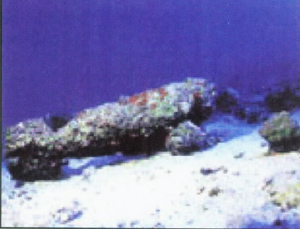 By this rationale, if I'm reading it correctly, due to the concentration and distribution of munitions in the Gulf — in the exact same areas of the Gulf, in fact, that had already been identified as primary drilling locations for a host of other reasons — drilling for oil on top of a minefield was essentially unavoidable. It was a foregone conclusion that BP was going to drill wherever they wanted, so it was important to put research papers like this out there, to give both sides a deceptively scientific smokescreen to point at when disaster unavoidably struck and everybody started flailing around for someone or something to blame.
By this rationale, if I'm reading it correctly, due to the concentration and distribution of munitions in the Gulf — in the exact same areas of the Gulf, in fact, that had already been identified as primary drilling locations for a host of other reasons — drilling for oil on top of a minefield was essentially unavoidable. It was a foregone conclusion that BP was going to drill wherever they wanted, so it was important to put research papers like this out there, to give both sides a deceptively scientific smokescreen to point at when disaster unavoidably struck and everybody started flailing around for someone or something to blame.
Not that there was really anything else to do at that point. After the blast, whatever its cause, eleven people were dead within seconds, millions of gallons of water were contaminated within days and, as the shockwave expands over the coming weeks, poisoning hundreds of miles of coastline and thousands of species of wildlife, the unavoidable reaction from those tasked with reacting to the crisis, will be to diagram and dissect and reconstruct the disaster, to run the simulation again and again, altering this or that variable, to wind all the facts and details, errors and lies, together, to rewind and retract the inevitable and all its repercussions to a single point outside of time when nothing was unavoidable.

